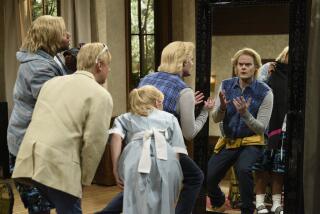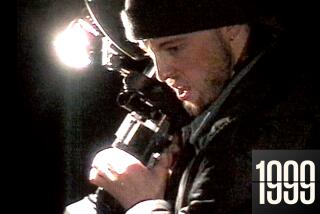‘George Bailey Here, Speaking on Behalf of Your Local S&L;’
So filmmakers and movie purists are up in arms about the use of clips and characters from old films in a Diet Coke commercial (“Not Quite the Real Thing,” Calendar, Dec. 16).
I admit the idea is jarring at first--maybe even a bit deceitful. But I beg to differ with the critics. I think it opens up a whole new way to help restore precious public confidence in some of our reputation-damaged institutions.
Say, for instance, the savings and loan industry--or what’s left of it. Dennis McDougal’s Calendar article mentions “It’s a Wonderful Life.” Imagine how the battered, discredited S&Ls; could benefit from using clips from that beloved Christmas classic to remind consumers of the industry’s past benevolence and altruism.
After all, the movie does center on the Bailey Bros. Building & Loan Assn., truly a paragon of a small-town, family-owned institution that stayed true to its founding principles, weathered hard times, survived the death of its founder--even fended off a hostile takeover attempted by the vulturous Mr. Potter.
For example, the S&Ls; want to distract people from the image of convicted ex-S&L; chieftain Charles Keating standing in the defendant’s dock? Presto! They could resurrect Peter Bailey, building and loan founder and father of James Stewart’s character George Bailey, as he tries to persuade his then-college-bound son to stay on with the company. Through this high-tech wizardry, viewers could see him addressing, say, Senate Majority Leader George Mitchell in a Senate hearing room--or even George Bush in the Oval Office:
“You know, George, I feel that in a small way we’re doing something important: satisfying a fundamental urge. It’s deep in the race for a man to want his own roof, and walls and fireplace. And we’re helping him get those things in our shabby little office.”
Now, that would be stirring!
Or, what could be more poignant than the scene where the selfless, civic-minded George Bailey uses the kitty for his own honeymoon to pay off panicked depositors. They could transpose this scene into an old videotape of a branch office of Denver’s now-defunct Silverado Savings (Neil Bush, ex-director) and . . . pow, probably a 20-point pickup in public opinion polls!
Now, I know what you’re thinking: But these celluloid fragments don’t square with what really happened in the S&L; debacle. OK, I admit there are some historical dissimilarities. Like the fact that today’s S&Ls; are in trouble or out of business not because they invested in people’s home sweet home, but in junk bonds, shaky real estate deals and see-through office buildings.
Too, the S&L; robber barons of the ‘80s hardly used their own personal funds to reimburse depositors; rather, they stole depositors’ money and spent it on their own personal perks--like jets, yachts, country club memberships, prostitutes, etc. But hey, that was then, this is now.
Of course, on the negative side, the thrift industry’s admen would have to watch out for other scenes that could cause problems. Like the one where the distraught George Bailey shakes Uncle Billy silly to prod his memory about the missing bank deposit:
“Where’s the money, you stupid old fool? Do you realize what this means? It means bankruptcy and scandal and prison! That’s what it means. One of us is goin’ to jail. Well, it’s not gonna be me!”
Ouch, that one would definitely hit a little too close to home.
And they’d also have to avoid at all costs any use of the tear-jerking finale, where townspeople line up at the Bailey residence to toss their hard-earned dollars and lifetime savings into a hat to make up for the missing funds. That would be too painful a reminder to taxpayers that they’ve involuntarily coughed up about $150 billion so far to bail out the mismanaged thrifts.
As for Clarence, the oddball but lovable heavenly emissary who saves George’s life, it would no doubt be downright dangerous to bring him back to life (or, to Earth). After all, viewers might be tempted to fantasize that some of today’s S&L; swindlers, instead of George Bailey, are standing on the bridge--and that the guardian angel actually lets them jump.
Or, tempted to figure how much better off the country would have been had Clarence granted to these characters George Bailey’s wish that he’d never lived at all.
Hmm. On second thought, maybe the critics are right, this whole thing isn’t such a good idea after all. In the wrong hands, this technology could be absolutely . . . underhanded.
More to Read
Only good movies
Get the Indie Focus newsletter, Mark Olsen's weekly guide to the world of cinema.
You may occasionally receive promotional content from the Los Angeles Times.










